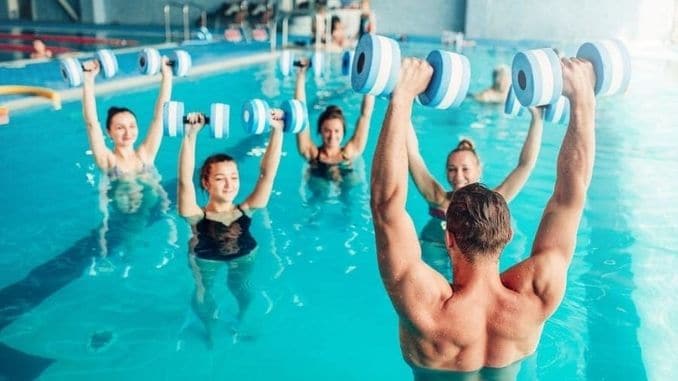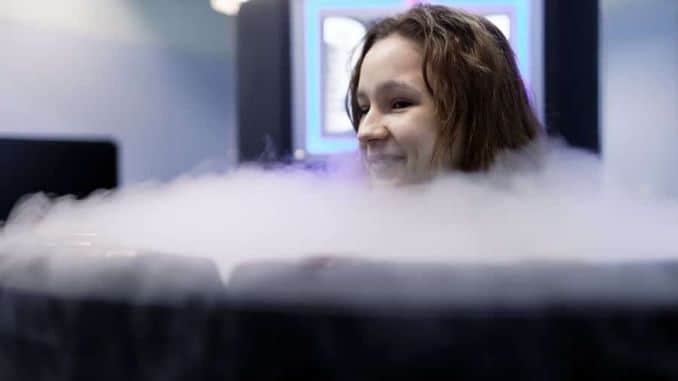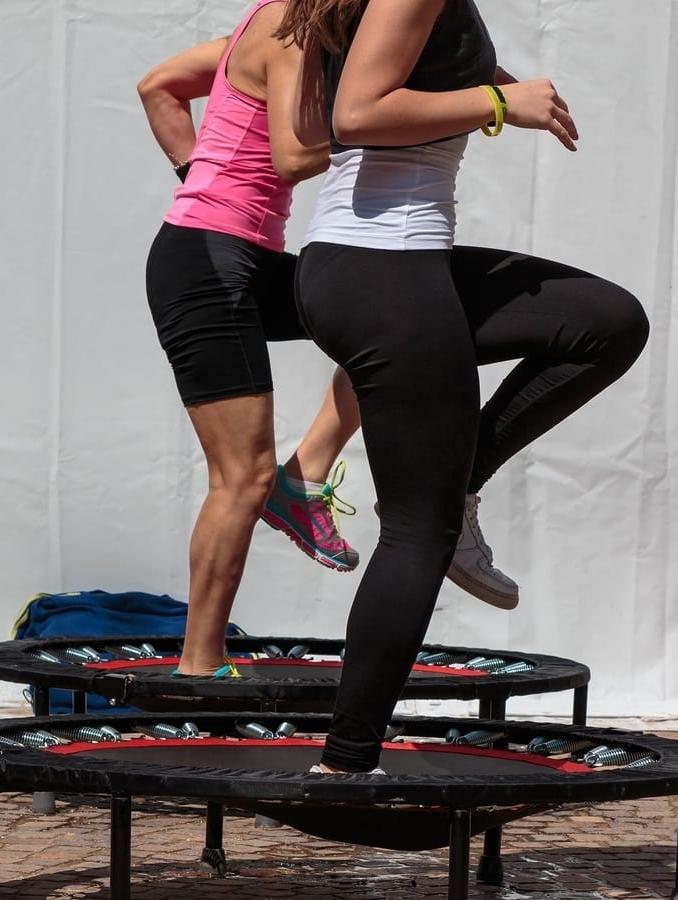
As the new year approaches, we’ve been combining fitness centers, health clinics, spas, and universities to find the most up-and-coming health trends for 2018. Some exciting new ideas are in store for us this year. Listed below are the seven Anticipated Health Trends for 2018 that caught our attention.

7 Anticipated Health Trends For 2018
1. Behold The Salt Spa
If you already have a cherished salt lamp in your home, you’ll go bonkers for halotherapy, a practice of using salt to heal the body and mind. The basic buy-in for salt therapy is this: we were all born of water and salt. So, with water and salt, we find our healing. That does make sense — all humans did float in salty amniotic fluid for nine months in the womb.
The jury is still out on documented evidence of healing. But, anecdotally, halotherapy hits the mark. Patients claim to heal of ailments like insomnia, tinnitus, sinus pain, depression, asthma and arthritis. Until recently, folks had to travel to places like Berchtesgaden, Germany, or Soligorsk, Belarus, to find natural salt caves for healing retreats. In 2018, you will be able to find halotherapy at a health spa near you.
Salt-loving entrepreneurs far and wide have begun to build their own versions of the caves in Germany and Belarus. Existing health spas are transforming spaces in their clinic into magical feeling “salt rooms.” Picture an empty room with large pink bricks of salt in place of drywall.
Instead of flooring, there’s gravel, which is also made from salt, and the ceiling is lined in pink Himalayan salt crystals. In the middle of a salt room, you’ll find chairs or other adjustable seating options for those who want to meditate. To protect the purity of the salt floor, guests must remove their shoes and wear booties instead.
Additionally, there are some stand-alone halotherapy clinics equipped with beds — think of an elevated bed-shaped sandbox — full of heated salt. The claim is that 30 minutes in one of these salt beds can bring wellness through contact with salt’s negative ions. One clinic in Ashville, North Carolina, has an actual cave built of salt. Healing retreats and special events use them. Look for salt therapy at your local spa this year.
2. Revisiting Water Fitness
Just when you thought it was safe to go back in the water, in comes that ever-so-energetic personal trainer. For 2018, hardcore underwater exercise comes to the local pool. Deep-water running, upright underwater cross-training, and shallow-water balance sessions are a handful of the activities that may help us redefine a “day at the pool” in 2018.
Exercise scientists have recently proclaimed that water is perhaps the most effective resistance tool available. Even though Aunt Marcella’s water aerobics class never looked particularly cool and cutting-edge, 2018 will change the game. Researchers have seen gains in strength, muscular coordination, and core stability. And overall balance in fit individuals who are involved in regular aquatic exercise.
Look for serious bodybuilders, yoga instructors and weight-room junkies to venture across to the aquatics room at the gym this year. Don’t be surprised if your personal trainer starts showing up to work in his wetsuit and clambering down the hall in snorkeling fins just to accommodate the Anticipated Health Trends.
3. Cryotherapy
Let’s face it: old-fashioned ice baths are out of style. For the Eskimo at heart, 2018 will bring the world more freestanding cryotherapy clinics. Cryotherapy treatments involve stripping down to your skivvies and entering an extremely cold, dry chamber for three minutes in the hopes of relieving inflammation. By “very cold,” we mean freeze-your-toes-off kinds of temperatures ranging from -166 to -315 degrees Fahrenheit.
Although isolated cold therapy has been practiced safely with excellent results for eons. The medical community does not convince everyone of the benefit of full-body cryotherapy treatments. The risk of such treatments is also a concern. Standing in an ultra-freezer without clothes on for too long can obviously cause death. However, cryotherapy will be a growing Anticipated Health Trends this year. Among those with a little extra cash, a lot of inflammation, and the desire to try anything once.
4. Goodbye Opiates, Hello Cannabis
Formerly known by such derogatory terms as reefer, weed and wacky tobacky, cannabis is now regarded as a legitimate, plant-derived medicine. Cannabis isn’t a new medicine to holistic doctors and herbalists. However, in the mainstream medical community, the therapeutic herb will get its due respect this year. As much of the Western world has decriminalized medical use of the plant, including all of Canada and 28 of the 50 U.S. states, practitioners and patients are turning to cannabis as a natural alternative to synthetic pharmaceuticals.
One of the most promising uses of the plant is in pain management. For the past few decades, doctors have routinely prescribed opiate drugs for pain relief. Obtain prescriptions for opiates for something as small as a tooth extraction or as significant as a hip replacement. Although opiates are sometimes effective for pain, they’re also highly addictive and dangerous when used for long periods.
Cannabis extracts offer an effective form of non-addictive pain relief that is much gentler on the body than opiates. Additionally, cannabis farmers are cultivating strains of the flowering plant that have been shown to relieve pain without inducing a “high” or psychoactive effect. Another bonus: you don’t have to smoke it! Tinctures, edibles, oils and vapors are readily available for healthy ingestion.
As a natural medicine, cannabis is extremely potent and should be regarded with care, in cooperation with your doctor or health care provider. It’s also wise to avoid purchasing it in fold-top bags from your neighbor’s sketchy teenager. Your best bet for medical-grade cannabis is a legal dispensary.
5. Fresh New Workouts For The Trampoline
It was hard for me to believe, but when Kae Etchegoin, president of DK Body International in Las Vegas told me that the trampoline was making a comeback in 2018, I looked into it. Sure enough, trampoline fitness as one of the Anticipated Health Trends is on the exercise class schedule in January at my local YMCA.
Why is there a sudden demand for bouncing? It turns out, many who have suffered injuries and have lingering joint pain have found that endurance work on the trampoline is easier on their joints than hitting the pavement. Also, those without the time for an hour of brisk walking each morning can spend just 20 minutes on the mini-tramp and get the same caloric burn.
Trampoline work improves balance. Surprisingly, using the trampoline may be a bounding blessing for your immune system. It’s been established that jumping up and down on the trampoline stimulates the body’s lymphatic system in a unique way, compared to other, less bouncy physical activities.
Some wellness advocates are encouraging their clients to incorporate the mini-tramp into their workout schedules to get a better variety of lymphatic activity. Thus, boosting immunity.
Even if the wellness pundits have got it all wrong, you’ll have more fun bouncing than jogging — guaranteed.
6. Demystifying The Macros
If you watch health trends like we do, you’ve probably already heard about the macronutrient diet. The four macronutrients for humans are water, protein, fat, and carbohydrates. Our bodies need the macronutrients every day to function optimally. In 2018, carbohydrate-elimination and fat-free pancakes will be about as popular as boot-cut jeans and hot pink hair. This year it’s all about nutrition and balance for better health.
Look for more restaurants and smoothie bars to offer more macronutrient-rich options this new year. For more information about the macronutrient diet, and tips on how to incorporate the concept into your life, check out Meal Planning for a Macronutrient Diet.
7. Tabata For More Efficient Gains
Tabata training was developed by Dr. Izumi Tabata, of Japan while he was researching high-intensity interval training (HIIT). It is a form of HIIT that’s excellent for serious athletes. If you’ve come to a place in your fitness routines where you aren’t seeing any new progress, Tabata could be the perfect solution for you.
The Tabata model is 20 seconds of hardcore, push-your-hardest work, followed by 10 seconds of rest. Followed by another set of the 20/10, and another, until 4 minutes have passed. Then, you move on to a new exercise for another four-minute circuit. Keep going until you’ve completed five rounds of 4-minute circuits.
Tabata training can take as little as 20 minutes a day. But, the method can take you from barely noticing your abdominal muscles to posting your eight-pack on Instagram in just a few weeks of training.
One of the tenets of Tabata training is this: If you aren’t feeling completely drained and pushed beyond your normal levels, then you haven’t worked at a high enough intensity. If that doesn’t scare you away, seek out a Tabata-fluent trainer in 2018.
Conclusion
Year after year, new concepts come and go in the world of health and fitness, and 2018 will be no exception. We’ll see new ideas on how to deal with pain, maintain a healthy weight and press on toward the goal of wellness for the body and mind. Let’s hope for an overwhelmingly healthy year for everyone. Happy 2018!
If you want to trim down your body, get younger, increase your metabolism and energy and heal your pain, then check out the Best Foods That Rapidly Slim & Heal in 7 Days program, here!




